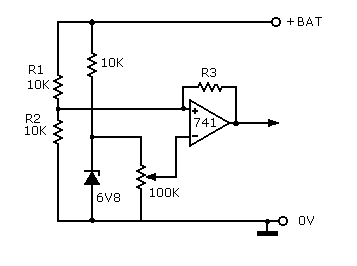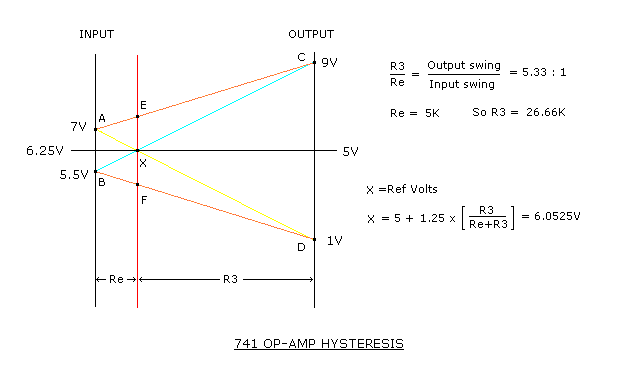| Author |
 Topic Topic  |
|
pebe
Nobel Prize Winner
    
United Kingdom
1078 Posts |
 Posted - Aug 13 2008 : 07:42:56 AM Posted - Aug 13 2008 : 07:42:56 AM


|
quote:
Can you show the formula in calculating that ' positive feedback '
Hi Juan,
Here is an explanation of the circuit you want, and the method of calculating the feedback.
When the output of the 741 toggles between two states it only goes to within 1V of the rails. So with the minimum battery voltage of 10V, the output will toggle between 1V and 9V. The difference is 8V with a midpoint of 5V
The input to the amp is the battery volts divided by R1 and R2, so will go between 5.5V and 7V. The difference is 1.5V with a midpoint of 6.25V.
Now look at the graph.
Re is the input resistance that the non-inverting input ‘sees’ from its source voltage. In your case it is R1 and R2 in parallel fed from ˝ the battery voltage. R3 is the feedback resistor.
The two vertical black lines are the input and output voltages. Point X is the reference voltage. If you take the horizontal axis to be the measure of the resistance between input and output, the vertical red line represents the voltage at the non-inverting input relative to the reference voltage.
The line AC shows a fully charged battery. The non-inverting input is at point E, ie. higher than the ref volts. As the battery discharges its input will drop from A towards B. When it finally gets to B its non-inverting input on line BC will be the same as the ref volts. At that point the output will toggle to give the line BD. F is now well below ref.
The battery voltage is now put on charge. As its voltage reaches 14V then the line BD will get to AD. The non-inverting input will then be the same as ref and the output will go high again to give line AC.
The reference voltage of 6.05 is selected with the 100K pot.
In fact, a fully charged battery will only reach 13.8V so the max voltage should be taken as 13.5 in order for the amp output to go high. But if I have explained things well enough you should be able to do the calculations.
Good luck.
Download Attachment:  OP-AMP Feedback.GIF OP-AMP Feedback.GIF
3.56 KB

Download Attachment:  opamp feedback.GIF opamp feedback.GIF
5.85 KB
 |
Edited by - pebe on Aug 13 2008 6:57:10 PM |
 |
|
|
mrgone
Nobel Prize Winner
    
USA
1176 Posts |
 Posted - Aug 13 2008 : 11:12:34 PM Posted - Aug 13 2008 : 11:12:34 PM


|
| That's how I remember it. It's a threshold. I think temperature has allot to do with it. Right pebe? |
 |
|
|
JUAN DELA CRUZ
Mad Scientist
   
Philippines
476 Posts |
 Posted - Aug 15 2008 : 02:50:13 AM Posted - Aug 15 2008 : 02:50:13 AM


|
quote:
Originally posted by pebe
quote:
Can you show the formula in calculating that ' positive feedback '
Hi Juan,
Here is an explanation of the circuit you want, and the method of calculating the feedback.
When the output of the 741 toggles between two states it only goes to within 1V of the rails. So with the minimum battery voltage of 10V, the output will toggle between 1V and 9V. The difference is 8V with a midpoint of 5V
The input to the amp is the battery volts divided by R1 and R2, so will go between 5.5V and 7V. The difference is 1.5V with a midpoint of 6.25V.
Now look at the graph.
Re is the input resistance that the non-inverting input ‘sees’ from its source voltage. In your case it is R1 and R2 in parallel fed from ˝ the battery voltage. R3 is the feedback resistor.
The two vertical black lines are the input and output voltages. Point X is the reference voltage. If you take the horizontal axis to be the measure of the resistance between input and output, the vertical red line represents the voltage at the non-inverting input relative to the reference voltage.
The line AC shows a fully charged battery. The non-inverting input is at point E, ie. higher than the ref volts. As the battery discharges its input will drop from A towards B. When it finally gets to B its non-inverting input on line BC will be the same as the ref volts. At that point the output will toggle to give the line BD. F is now well below ref.
The battery voltage is now put on charge. As its voltage reaches 14V then the line BD will get to AD. The non-inverting input will then be the same as ref and the output will go high again to give line AC.
The reference voltage of 6.05 is selected with the 100K pot.
In fact, a fully charged battery will only reach 13.8V so the max voltage should be taken as 13.5 in order for the amp output to go high. But if I have explained things well enough you should be able to do the calculations.
Good luck.
Download Attachment:  OP-AMP Feedback.GIF OP-AMP Feedback.GIF
3.56 KB

Download Attachment:  opamp feedback.GIF opamp feedback.GIF
5.85 KB

Hi Mr. Pebe..
Sorry for not replying this past days.. (due to budget reason ) )
Anyway, based on your explaination above.. I will try to design a Window comparator with 11V cut-off (low voltage detection)
& 14V cut-off(high voltage detection)
---- I will post my diagram later-----
I really appreciate your kindness Sir..
Thank you |
juan dela cruz
Penniless INVENTOR |
Edited by - JUAN DELA CRUZ on Aug 15 2008 02:51:23 AM |
 |
|
|
pebe
Nobel Prize Winner
    
United Kingdom
1078 Posts |
 Posted - Aug 15 2008 : 05:49:17 AM Posted - Aug 15 2008 : 05:49:17 AM


|
If it's for a low battery cut-off, then 14V is too high. A charged battery will never get up to that level.
Try designing for 11V to 13V |
 |
|
|
JUAN DELA CRUZ
Mad Scientist
   
Philippines
476 Posts |
 Posted - Aug 15 2008 : 06:08:03 AM Posted - Aug 15 2008 : 06:08:03 AM


|
quote:
Originally posted by pebe
If it's for a low battery cut-off, then 14V is too high. A charged battery will never get up to that level.
Try designing for 11V to 13V
Greetings..
11V for LOW battery cut-off
14V for HIGH battery cut-off (will be use together with battery CHARGER)... for ' automatic ' BACK-up Powersupply (MSW Inv.)
-- Do you think they can have only one input voltage (& different Ref. voltage)
-- If the non-inverting input (+ve) has the Ref. voltage..
can IT have feedback?... you said the resistance of ZENER is "0".
Thank you
|
juan dela cruz
Penniless INVENTOR |
Edited by - JUAN DELA CRUZ on Aug 15 2008 06:10:51 AM |
 |
|
|
JUAN DELA CRUZ
Mad Scientist
   
Philippines
476 Posts |
 Posted - Aug 15 2008 : 07:10:53 AM Posted - Aug 15 2008 : 07:10:53 AM


|
I am quite confused..
I've searched in google and find this equation:
T = V(Re)/ Rf
Where:
T - Threshold
V - Supply voltage
Re - Resistance combined
Rf - Positive Feedback
--- The threshold will be the difference of the max supply voltage & the Target voltage cut-off ?
--- Re is the combined resistance of the voltage Divider regardless of the feedback resistor ?
Thank you |
juan dela cruz
Penniless INVENTOR |
Edited by - JUAN DELA CRUZ on Aug 15 2008 07:13:07 AM |
 |
|
|
pebe
Nobel Prize Winner
    
United Kingdom
1078 Posts |
 Posted - Aug 15 2008 : 08:37:06 AM Posted - Aug 15 2008 : 08:37:06 AM


|
quote:
Originally posted by JUAN DELA CRUZ
..14V for HIGH battery cut-off (will be use together with battery CHARGER)... for ' automatic ' BACK-up Powersupply (MSW Inv.)
You seem to have missed the point. If your High 'cut-off' is 14V, the circuit will never reach the change-over state when the battery has charged, because a charged battery will only reach about 13.8V quote:
-- Do you think they can have only one input voltage (& different Ref. voltage
-- If the non-inverting input (+ve) has the Ref. voltage..
can IT have feedback?... you said the resistance of ZENER is "0".
I don't know what you mean. Did you understand the explanation I gave you?
quote:
I am quite confused..
I've searched in google and find this equation:
T = V(Re)/ Rf
Where:
T - Threshold
V - Supply voltage
Re - Resistance combined
Rf - Positive Feedback
--- The threshold will be the difference of the max supply voltage & the Target voltage cut-off ?
--- Re is the combined resistance of the voltage Divider regardless of the feedback resistor ?
What threshold do you mean?
The formula is quite meaningless without the circuit it refers to.
|
 |
|
|
mrgone
Nobel Prize Winner
    
USA
1176 Posts |
 Posted - Aug 15 2008 : 08:57:25 AM Posted - Aug 15 2008 : 08:57:25 AM


|
quote:
Originally posted by JUAN DELA CRUZ
I am quite confused..
I've searched in google and find this equation:
T = V(Re)/ Rf
Where:
T - Threshold
V - Supply voltage
Re - Resistance combined
Rf - Positive Feedback
--- The threshold will be the difference of the max supply voltage & the Target voltage cut-off ?
--- Re is the combined resistance of the voltage Divider regardless of the feedback resistor ?
Thank you
Juan, are trying to make a window detection circuit or just do the calculations? You do understand that you need two Op-Amps? So think of it in those terms. What you have is two "voltage level detectors". One will turn on when threshold is detected, and the other will turn off. So yes, you basically set the threshold with the voltage divider. |
 |
|
|
pebe
Nobel Prize Winner
    
United Kingdom
1078 Posts |
 Posted - Aug 15 2008 : 09:10:30 AM Posted - Aug 15 2008 : 09:10:30 AM


|
Mrgone, I think he wants this for a low-voltage battery detector which recovers when the battery reaches max voltage. If so, it should only react to voltages outside the window - in other words a flip flop with hysteresis.
That is easily achieved with a single opamp as I described. |
 |
|
|
mrgone
Nobel Prize Winner
    
USA
1176 Posts |
 Posted - Aug 15 2008 : 11:48:06 PM Posted - Aug 15 2008 : 11:48:06 PM


|
| Oh yeah. He only needs to detect on level. Like a digital trickle charger. |
 |
|
|
JUAN DELA CRUZ
Mad Scientist
   
Philippines
476 Posts |
 Posted - Aug 16 2008 : 02:55:21 AM Posted - Aug 16 2008 : 02:55:21 AM


|
Hi everyone..
What I want is to:
-- turn off the MSW Inverter when the battery is LOW (11.5V)
*LOW BATT CUT-OFF
-- turn on the battery charger to the charge the battery.
When the battery was Fully charge...
-- charging will STOP automatically
(LIKE THE UNINTERRUPTIBLE PSUPPLY FOR PC)
Do you think I will need a "3" detection ckt. to achieve THIS ?
Thank you |
juan dela cruz
Penniless INVENTOR |
Edited by - JUAN DELA CRUZ on Aug 16 2008 02:56:22 AM |
 |
|
|
pebe
Nobel Prize Winner
    
United Kingdom
1078 Posts |
 Posted - Aug 16 2008 : 04:24:00 AM Posted - Aug 16 2008 : 04:24:00 AM


|
You need two different controls.
1. A relay that will switch on the inverter when mains is not available. When mains is available the battery will be automatically charged and the inverter switched off.
2. A 2 level detector that (when no mains is available and the inverter is being used) switches off the inverter when battery voltage has dropped to 11V, and switches it on when battery reaches 13V. |
 |
|
|
JUAN DELA CRUZ
Mad Scientist
   
Philippines
476 Posts |
 Posted - Aug 16 2008 : 04:58:06 AM Posted - Aug 16 2008 : 04:58:06 AM


|
quote:
Originally posted by pebe
You need two different controls.
Greetings..
quote:
1. A relay that will switch on the inverter when mains is not available. When mains is available the battery will be automatically charged and the inverter switched off.
--How can I disconnect the inverter to the Transformer when the mains is available?
(I will use the inverter's transformer for charging)
quote:
2. A 2 level detector that (when no mains is available and the inverter is being used) switches off the inverter when battery voltage has dropped to 11V, and switches it on when battery reaches 13V.
--Battery will reach 13.8V if Fully charge? So 13V is not fully charge?
Thank you |
juan dela cruz
Penniless INVENTOR |
 |
|
|
pebe
Nobel Prize Winner
    
United Kingdom
1078 Posts |
 Posted - Aug 16 2008 : 08:09:33 AM Posted - Aug 16 2008 : 08:09:33 AM


|
A Swiss Army knife is a pocket knife with additional built-in tools that can do many things. But it cannot do any of them as good as dedicated individual tools would.
By trying to use the same transformer for charging and for the inverter, you will end up with a similar thing. You are making complications for yourself which take more and more circuitry to work.
You started out trying to make a simple converter. Why not keep it that way and build a separate charger? |
 |
|
|
mrgone
Nobel Prize Winner
    
USA
1176 Posts |
 Posted - Aug 16 2008 : 1:53:09 PM Posted - Aug 16 2008 : 1:53:09 PM


|
quote:
Originally posted by JUAN DELA CRUZ
quote:
Originally posted by pebe
You need two different controls.
Greetings..
quote:
1. A relay that will switch on the inverter when mains is not available. When mains is available the battery will be automatically charged and the inverter switched off.
--How can I disconnect the inverter to the Transformer when the mains is available?
(I will use the inverter's transformer for charging)
quote:
2. A 2 level detector that (when no mains is available and the inverter is being used) switches off the inverter when battery voltage has dropped to 11V, and switches it on when battery reaches 13V.
--Battery will reach 13.8V if Fully charge? So 13V is not fully charge?
Thank you
You are confusing me here. Why would you want to shut off the charger when the battery is low or did I read that wrong?
If you want to disconnect the charge voltage you can use a relay.
Is this a battery back up system? You keep talking about a "main". So maybe what you are saying is you want a system that will supply voltage to a device like a computer and it will also check the battery charge level. If the power goes out then it will switch to battery power. Is this correct? |
 |
|
 Topic Topic  |
|

